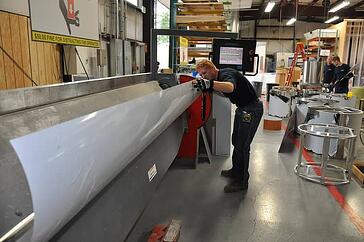5S Your Way To Efficiency and Profitability – Part 2
 We organize and clean at home. Doing the same at our manufacturing facilities and offices will increase both efficiency and our bottom line. This is Part 2 of a two-part series that discusses how manufacturing organizations can utilize the 5S methodology to establish a strong foundation of discipline needed to increase efficiency and profitability. Part 1 discussed how the 5S methodology assists manufacturers with uncovering and removing variation from their facilities – read it here.
We organize and clean at home. Doing the same at our manufacturing facilities and offices will increase both efficiency and our bottom line. This is Part 2 of a two-part series that discusses how manufacturing organizations can utilize the 5S methodology to establish a strong foundation of discipline needed to increase efficiency and profitability. Part 1 discussed how the 5S methodology assists manufacturers with uncovering and removing variation from their facilities – read it here.
What are the Benefits of 5S?
- Improved quality - A clean environment fosters better attitudes and conscious attention to detail
- Improved deliveries - Fewer errors due to organized work areas, more focus on producing what customers need
- Increased safety - Less clutter, cleaner floors, clear boundaries for truck/foot traffic, item locations clearly marked
- Fewer equipment failures - Easier to spot equipment leaks without dirt, chips, or dust
- Improved morale - Cleaner, safer, and organized work environment
- Improved cash flow and profitability - Reduced operating cost
The Concept of 5S Originated in the USA---Not in Japan
These concepts did not originate in Japan, but came from the United States. Visionaries including Henry Ford, pioneers such as Frederick Taylor, Frank Gilbreth, Harrington Emerson, and Charles Knoeppel began describing waste in manufacturing and identifying methods for reducing it. CANDO was Mr. Ford’s vision for supporting continuous improvement and the precursor of 5S---Clearing up, Arranging, Neatness, Discipline, and Ongoing improvement. Note the similarities between CANDO and 5S.
Mr. Henry Ford wrote in his book Today and Tomorrow (1926): "The first job was to clean up— that is always the first thing to do in order to find out what you are about…We cannot afford to have dirt around— it is too expensive. … Everything is painted and kept painted a light color, so the least bit of dirt will show. We do not paint to cover up dirt— we paint white or light gray in order that cleanliness may be the order of things and not the exception."
Visual 5S Workplaces Offer Continual Feedback
Visual methods introduced into our workplaces help us recognize and identify problems. Red tagging is a visual method for recognizing and removing waste, although after the waste has already been created. A visual tool that will help us reduce the amount of items that will eventually be red tagged is Kanban.
Kanban are authorizations to either produce or purchase materials needed for production. Downstream processes request additional materials only when needed from upstream processes. Pulling materials when needed avoids making/buying items that are not required, resulting in lower inventories, improved customer service, and increased quality. Kanbans are visual cards or tags used to communicate replenishments. Kanban also introduced visual signals such as signage and striping floors. For example, markings floors for designated inventory locations can quickly indicate whether there is need to replenish or not. Consequently, Kanban can be thought of as reducing waste through facilitating the Organization stage of 5S.
Painting/taping work areas, boundaries, and storage areas are examples of visual Orderliness. With these areas designated, anyone can quickly determine where things belong and when things are out of place. Color-coding tools, fixtures, and devices such as air or water lines helps us identify what type or category the items are and what machine uses them.
We may introduce checklists as visual Cleanliness tools to help manage inventory, equipment, and physical spaces. Posting daily equipment inspection checklists, for example, reminds operators of the specific tasks they must perform each shift.
What are the Key Steps for a Successful 5S Program?
- Begin with top management’s support and commitment.
- Without their approval and clear sanctioning of ANY Lean tools, success will be difficult to sustain.
- Identify and select a 5S team to “market” and communicate the program throughout the organization.
- Include at least one senior manager.
- Walk through the entire program with everyone on the team.
- Encourage everyone in the company to participate in the program.
- Prepare your implementation plan and 5S strategy.
- Where will you begin?
- Will the entire facility be worked on at once (best approach) or broken down into areas?
- When will you begin?
- Gather needed supplies, facility drawings, tape, red tags, etc.
- Conduct company-wide education to communicate the program.
- Implement.
- Sustain through auditing, continuous communications, and marketing of the 5S successes.
- Maintaining and improving the effectiveness of the 5S program.
If you enjoyed this blog post, you might also be interested in "Why Business Process Improvement is Still Important."
This post was co-authored by Charles Keberdle:
Charles is a Senior Manager in Meaden & Moore's Business Solutions Group. He has over 30 years of experience within operations management and supply chain optimization and has led or participated in over twenty enterprise software selection projects and multiple ERP implementations during his career.
Image credit: In Shop Casino Décor | Casino Decor Manufacture | Casino Element Fabrication | Little Creek Casino by I-5 Design & Manufacture via Creative Commons License Attribution-NonCommercial-NoDerivs 2.0
Scott Holter is the Director of Meaden & Moore’s Business Solutions Group. He has spent 20 plus years in manufacturing and technology consulting.








